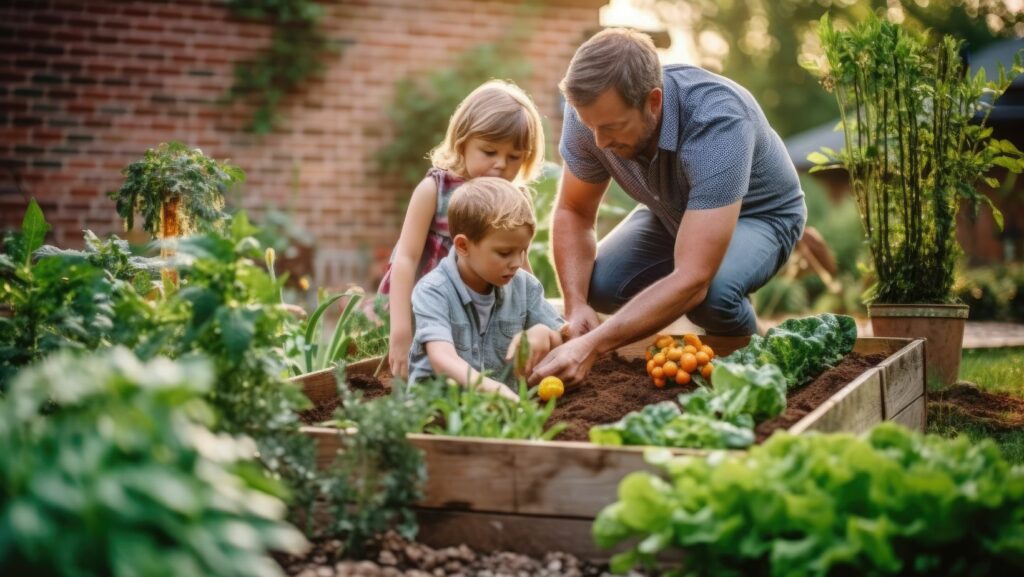Gardening brings families together in a unique way. It’s an activity that mixes fun, learning, and health benefits for everyone involved. From toddlers to grandparents, family gardening offers something special for each family member.
Why Choose Family Gardening?
Gardening as a family activity has many perks. It gets everyone outside, away from screens and into nature. Kids learn where food comes from and pick up new skills. Adults find a stress-relieving hobby. The whole family gets to enjoy fresh, home-grown produce.
But that’s not all. Family gardening also builds stronger bonds. Working together on a shared project creates lasting memories. It teaches patience, responsibility, and the value of hard work. Plus, it’s a great way to stay active without feeling like you’re exercising.
Getting Started: Planning Your Family Garden
Starting a family garden doesn’t have to be complicated. Begin with a small plot or even a few pots on a balcony. You may also explore rectangular planters right away if you want to take your gardening to the next level. Choose easy-to-grow plants that match your climate and available space. Vegetables like tomatoes, lettuce, and carrots are good options for beginners.
Involve everyone in the planning process. Let kids pick some plants they want to grow. This gives them a sense of ownership and excitement about the project. Make a list of needed supplies together and plan a family trip to the garden center.
Remember, the goal is to have fun and learn together. Don’t worry if things aren’t perfect. Every gardening mishap is a chance to learn something new.
Choosing the Right Plants for Your Family Garden
When selecting plants, think about what your family likes to eat. Growing familiar vegetables can encourage picky eaters to try new things. How exciting to eat a salad made from lettuce you grew yourself!
Consider the growing season in your area. Some plants thrive in cool weather, while others need lots of sun. Mix quick-growing plants like radishes with slower ones like pumpkins. This way, there’s always something happening in the garden.

Don’t forget to add some flowers. They make the garden pretty and attract helpful insects. Sunflowers are fun for kids to grow because they get so tall.
Garden Tasks for Every Age
Gardening offers jobs for everyone, no matter their age or ability. Younger kids can help with watering or picking ripe vegetables. Older children might enjoy planting seeds or helping to design the garden layout.
Adults can handle heavier tasks like digging or building raised beds. Grandparents can share their wisdom and experience, teaching traditional gardening techniques to the younger generations.
Rotate tasks so everyone gets to try different things. This keeps the experience fresh and exciting for all family members.
Learning Opportunities in the Garden
A family garden is like an outdoor classroom. It teaches valuable lessons about science, math, and nature. Kids learn about plant life cycles, weather patterns, and the role of insects in pollination.
Measuring and planning the garden space involves practical math skills. Keeping a garden journal improves writing and observation skills. Researching plant care teaches how to find and use information.
These lessons happen naturally as you work in the garden. They’re hands-on experiences that stick with kids far better than textbook learning.
Health Benefits of Family Gardening
Gardening is good for both physical and mental health. It’s a form of exercise that doesn’t feel like a chore. Digging, planting, and weeding all provide a good workout.
Being outside in the fresh air and sunshine boosts mood and vitamin D levels. Gardening can lower stress and improve mental well-being for all family members.
Growing your own fruits and vegetables encourages healthier eating habits. Kids are more likely to try vegetables they’ve grown themselves. This can lead to better nutrition for the whole family.
Overcoming Common Gardening Challenges
Every garden faces challenges. Pests, weather, and busy schedules can all cause problems. But overcoming these issues together can make your entire family stronger. To help manage these challenges in today’s digital age, many gardeners use garden tracking software which allows families to log plant health, set reminders for care tasks, and manage pest solutions collaboratively.
If pests attack your plants, research natural solutions as a family. Bad weather? Use it as a chance to learn about climate and plant adaptation. Busy schedules making it hard to keep up? Set up a family gardening time that works for everyone.
Remember, the process is just as important as the result. Even if your harvest isn’t perfect, the quality time spent together is valuable.
Celebrating Your Harvest
The best part of family gardening is enjoying the harvest together. Plan special meals featuring your home-grown produce. Try new recipes that use the vegetables you’ve grown.
Consider sharing your harvest with neighbors or donating to a local food bank. This teaches kids about community and sharing.

Take pictures of your garden’s progress and the dishes you make. Create a family gardening scrapbook to remember your adventures.
Extending the Gardening Experience
Gardening doesn’t have to stop when summer ends. Extend the experience with related activities throughout the year. Try canning or freezing your harvest to enjoy later. Start an indoor herb garden for fresh herbs all year round.
Visit local farms or gardening shows as a family. These trips can inspire new ideas for next year’s garden and keep everyone excited about gardening.
Conclusion
Family gardening is more than just growing plants. It’s about growing closer as a family, learning new skills, and creating healthy habits. It combines fun, education, and wellness in a unique way.
Starting a family garden might seem challenging, but the rewards are worth it. From the first seed planted to the final harvest, every step offers a chance for family bonding and personal growth.
So grab some seeds, get your hands dirty, and start your family gardening adventure. The memories and skills you cultivate will last far longer than any single growing season.
